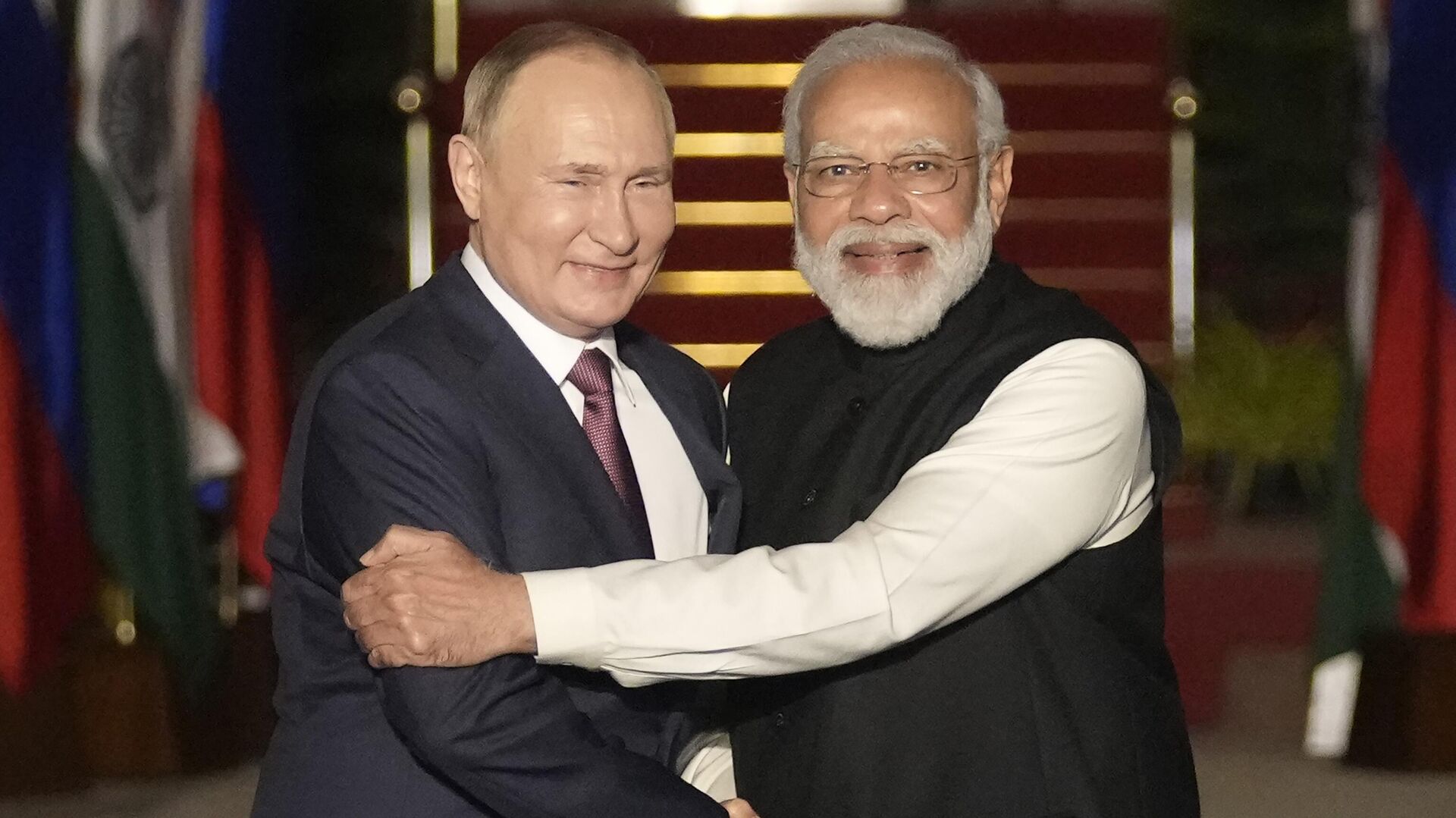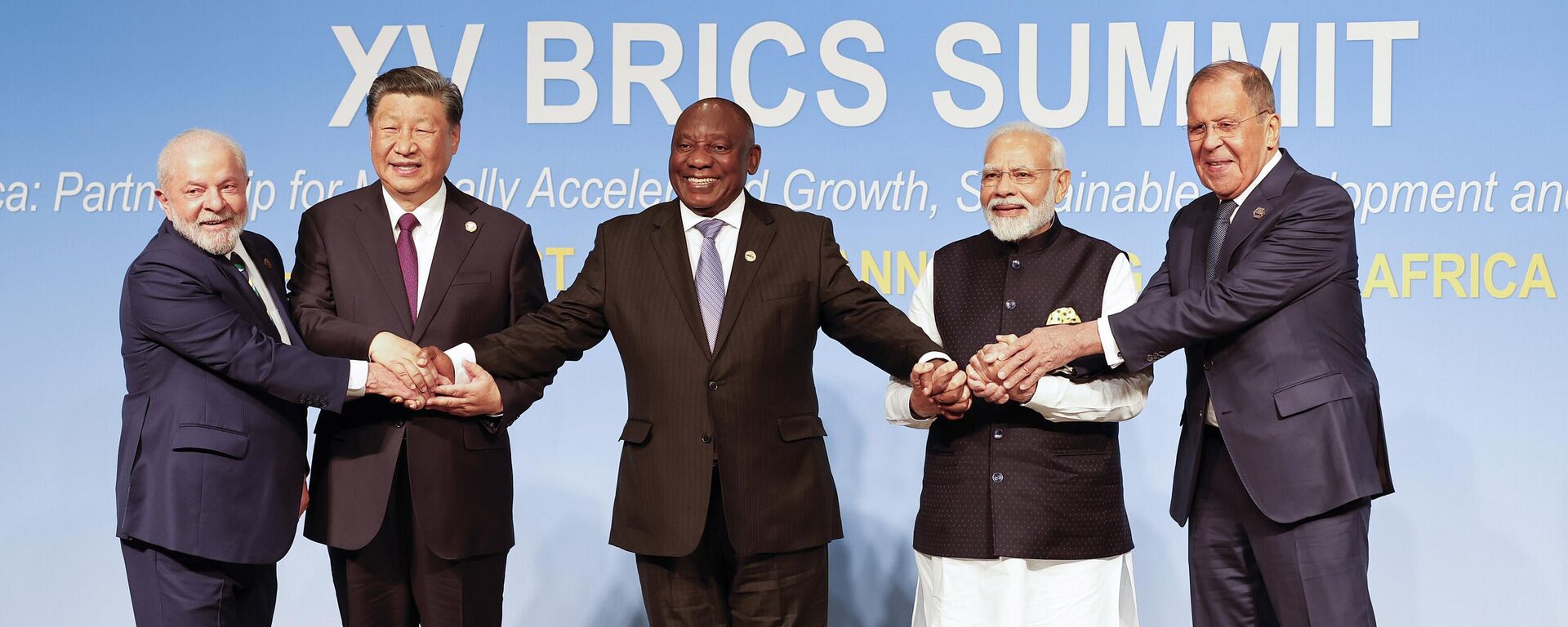https://sputniknews.in/20250404/us-announces-sharp-tariffs-on-india-how-does-this-open-doors-for-russia-8942071.html
Trump Tariffs: Russia’s Doors Swing Open For India
Trump Tariffs: Russia’s Doors Swing Open For India
Sputnik India
US President Donald Trump imposed 26 percent tariffs on Indian imports, which would considerably impact Indian businesses and goods. Sputnik India examines how... 04.04.2025, Sputnik India
2025-04-04T09:25+0530
2025-04-04T09:25+0530
2025-04-04T19:22+0530
sputnik opinion
brics
donald trump
india
russia
us
western sanctions
sanctions
jawaharlal nehru university (jnu)
trade
https://cdn1.img.sputniknews.in/img/07e9/03/05/8834364_0:0:3071:1727_1920x0_80_0_0_cd3e97f8f9448cc3f9289b0a385e9be8.jpg
Russia has become an attractive alternative for Indian businesses following the Donald Trump administration's move to levy a 26% tariff on imports from the South Asian nation amid the American leader's growing attempts to "weaponise trade", experts have told Sputnik India.The risk of such US action on India always existed. The Indian side has repeatedly stated that they understand, in principle, that sooner or later, America will inevitably apply sanctions on them because they are starting to compete in terms of the global economy, Valentin Makarov, the President of the Russian Software Developers Association (RUSSOFT) told Sputnik India.An example of how sanctions were applied to Russia showed that Russia, with its relatively small population, was able to prove to itself, America, and the whole world that it possesses technological sovereignty, the financial pundit highlighted.This means that its IT systems continue to function despite all American companies leaving the market and abandoning projects they were obligated to maintain, he said. The number of cyberattacks increased several times compared to pre-war times. Nonetheless, the global IT system in Russia continues to work despite everything, he pointed out.The Russian side is preparing joint projects for the transfer of technologies built on trust with India. Russia is also making technology transfers, training Indian specialists, jointly developing and improving technologies to meet international competitive standards, the business analyst noted.He underscored that in exchange, Russia first gains access to the government market, and then, by developing solutions for the Indian market, it begins to expand into the commercial market, competing with American, Chinese, and other products, but now from the position of a Russian-Indian company created and operating in India.Russia would definitely become a key factor for India as far as trade is concerned, reckons market analyst Arun Kejriwal.After all, India has very cordial relations with Russia, especially when one realises the kind of potential the two countries have, both in terms of industry and raw material. If India has an abundance of skilled manpower, Russia is rich in critical minerals, he observed.These tariffs are nothing but a weaponisation of trade launched by the US on the rest of the world, particularly on developing countries, Dr Anuradha Chenoy, former professor at Jawaharlal Nehru University (JNU), suggested in interview with Sputnik India.Interestingly, tariffs are set after prolonged bilateral and multilateral negotiations, including the active involvement of the World Trade Organization (WTO). This, therefore, represents another challenge to the rule-based order that the US frequently refers to. As a result, it is important to understand that Trump is attempting to disrupt global value and trade chains that took years to establish, she explained.However, she suggested that in order to secure investments from India, Russia needs to understand the challenges faced by Indian businesses.Notably, India's pharma sector has been spared, India exports tonnes of generic drugs to the US, and levying tariffs on them would have hurt the American health sector badly..While India may seemingly gain a marginal price advantage over China (8%) in certain low-risk, high-volume consumables, the real impact may not be significant if the prices of Indian products are more than 15% higher, stated Himanshu Baid, Managing Director of Poly Medicure, one of the leading medical device companies.
https://sputniknews.in/20250314/brics-discusses-food-sovereignty-amid-us-tariff-threats-8862491.html
india
russia
us
Sputnik India
feedback.hindi@sputniknews.com
+74956456601
MIA „Rossiya Segodnya“
2025
Pawan Atri
https://cdn1.img.sputniknews.in/img/07e6/0c/13/139630_147:0:831:684_100x100_80_0_0_8fa2b25903e7787fe6a2698552c167df.png
Pawan Atri
https://cdn1.img.sputniknews.in/img/07e6/0c/13/139630_147:0:831:684_100x100_80_0_0_8fa2b25903e7787fe6a2698552c167df.png
News
en_IN
Sputnik India
feedback.hindi@sputniknews.com
+74956456601
MIA „Rossiya Segodnya“
Sputnik India
feedback.hindi@sputniknews.com
+74956456601
MIA „Rossiya Segodnya“
Pawan Atri
https://cdn1.img.sputniknews.in/img/07e6/0c/13/139630_147:0:831:684_100x100_80_0_0_8fa2b25903e7787fe6a2698552c167df.png
brics, donald trump, india, russia, us, western sanctions, sanctions, jawaharlal nehru university (jnu), trade, world trade organization (wto)
brics, donald trump, india, russia, us, western sanctions, sanctions, jawaharlal nehru university (jnu), trade, world trade organization (wto)
Trump Tariffs: Russia’s Doors Swing Open For India
09:25 04.04.2025 (Updated: 19:22 04.04.2025) US President Donald Trump imposed 26 percent tariffs on Indian imports, which would considerably impact Indian businesses and goods. Sputnik India examines how these harsh American measures open up opportunities for India and Russia to cooperate.
Russia has become an attractive alternative for Indian businesses following the Donald Trump administration's move to levy a 26% tariff on imports from the South Asian nation amid the American leader's growing attempts to "weaponise trade", experts have told Sputnik India.
The risk of such US action on India always existed. The Indian side has repeatedly stated that they understand, in principle, that sooner or later, America will inevitably apply sanctions on them because they are starting to compete in terms
of the global economy,
Valentin Makarov, the President of the Russian Software Developers Association (RUSSOFT) told
Sputnik India.An example of how sanctions were applied to Russia showed that Russia, with its relatively small population, was able to prove to itself, America, and the whole world that it possesses technological sovereignty, the financial pundit highlighted.
This means that its IT systems continue to function despite all American companies leaving the market and abandoning projects they were obligated to maintain, he said. The number of cyberattacks increased several times compared to pre-war times. Nonetheless, the global IT system in Russia continues to work despite everything, he pointed out.
"Other countries, especially India, which is the largest country in terms of population, immediately took note of this and began negotiating with Russia, saying, 'We also want you to transfer your technological sovereignty know-how to us.' On this basis, we have been negotiating with Indian partners for about 2.5 years, and we've made considerable progress along this path. At the very least, there is trust on both sides," Makarov emphasised.
The Russian side is preparing joint projects for the transfer of technologies built on trust with India. Russia is also making technology transfers, training Indian specialists, jointly developing and improving
technologies to meet international competitive standards, the business analyst noted.
He underscored that in exchange, Russia first gains access to the government market, and then, by developing solutions for the Indian market, it begins to expand into the commercial market, competing with American, Chinese, and other products, but now from the position of a Russian-Indian company created and operating in India.
"This ideology works very well. It works in India, as well as in other Southeast Asian countries and Latin America. With this approach, significant progress is guaranteed because Russia offers sovereignty, cooperation, fairness, and reasonableness so that this cooperation is built not only on ideological principles but based on real indicators of profit and sales volume – everything that can be measured and always compared, to see whether one is better or worse than one's competitors," Makarov emphasised.
Russia would definitely become a key factor for India as far as trade is concerned, reckons market analyst Arun Kejriwal.
After all, India has very cordial relations with Russia, especially when one realises the kind of potential the two countries have, both in terms of industry and raw material. If India has an abundance of skilled manpower, Russia is rich in critical minerals, he observed.
"Moreover, there would be a realignment of nations over the next couple of weeks, where existing associations or organisations like the BRICS, G20, and ASEAN could see some kind of movement or change happening," Kejriwal said in an interview with Sputnik India.
These tariffs are nothing but a weaponisation of trade launched by the US on the rest of the world, particularly on developing countries, Dr Anuradha Chenoy, former professor at Jawaharlal Nehru University (JNU), suggested in interview with Sputnik India.
Interestingly, tariffs are set after prolonged bilateral and multilateral negotiations, including the active involvement of the
World Trade Organization (WTO). This, therefore, represents another challenge to the rule-based order that the US frequently refers to. As a result, it is important to understand that Trump is attempting to disrupt
global value and trade chains that took years to establish, she explained.
"For that reason, it would be better if India starts having more trade with Russia. But both nations need to work together to remove certain roadblocks like banking, repatriation, logistics, exchange rates, and insurance. The Russians will have to have bigger trade offices in India if they have to expand their trade here," the academic underlined.
However, she suggested that in order to secure investments from India, Russia needs to understand the challenges faced by Indian businesses.
Notably, India's pharma sector has been spared, India exports tonnes of generic drugs to the US, and levying tariffs on them would have hurt the American health sector badly..
While India may seemingly gain a marginal price advantage over China (8%) in certain low-risk,
high-volume consumables, the real impact may not be significant if the prices of Indian products are more than 15% higher, stated
Himanshu Baid, Managing Director of Poly Medicure, one of the leading medical device companies.
"Despite the tariff challenges, India's primary obstacle remains non-tariff barriers rather than tariffs themselves. Regulatory hurdles in the US are steep, with FDA approval costs ranging from $9,280 to over $540,000, whereas US exporters face relatively minimal costs when entering India. Addressing these imbalances through bilateral collaboration is crucial," he concluded.



